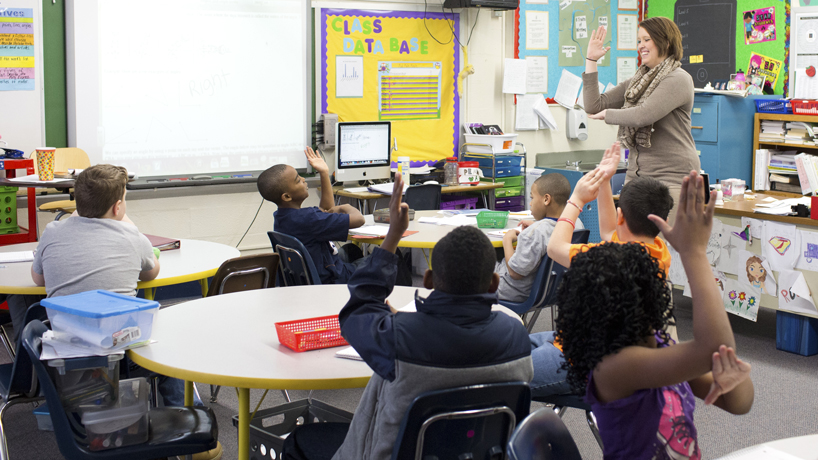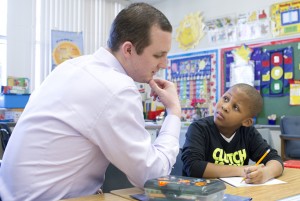
UMSL teacher candidate Casey Knaust teaches a fourth grade class at Parker Road Elementary School in Florissant, Mo., about angles. Knaust has the students demonstrate with her acute, right, obtuse, straight and reflex angles. (Photo by August Jennewein)
Sarah Schroeder and Heather Gain stand before 18 wide-eyed and engaged second graders, as the two women feed off of each other’s energy while reviewing the week’s vocabulary words.
Schroeder, an elementary education major at the University of Missouri–St. Louis, is a teacher candidate spending a semester in Gain’s classroom at Parker Road Elementary School in the Ferguson-Florissant (Mo.) School District.
Parker Road is just one of 32 schools to recently become a Studio School site for UMSL’s College of Education students.
But it’s not the student-teaching model of the past, which matched one student with one teacher for a semester and worked mostly with a watch-and-observe model. The Studio School model has the teacher candidates teaching from day one.
“Studio Schools are where design happens,” says Stephanie Koscielski, director of clinical experiences and school partnerships in the College of Education at UMSL. “We place teams of candidates in a school, where they become co-professionals working alongside the teachers.”
UMSL’s College of Education faculty created the Studio Schools model as a way to better prepare future teachers for the classroom.
The framework of a Studio School is called ResponsiveDesign, which focuses on raising student achievement and deepening learning.
“It’s a real data-driven process,” Koscielski says. “And it’s really powerful. The teacher candidates are continuously asked to analyze student learning outcomes and to differentiate their instruction to meet students’ needs.”
The team, which at Parker Road is 14 teacher candidates, spends a full school year teaching in several classrooms.
This gives UMSL teacher candidates the opportunity to teach in several different grade levels, alongside teachers with different teaching styles, while connecting to the school community as a whole.
Another component of the new model is the interaction teacher candidates have with students even before they get into the classroom.
“Leading up to that last year when they are placed in a school, our teacher candidates clock about 100 hours of service with a partnering youth-serving agency,” says Ann Taylor, associate dean of the college. “They provide focused academic support for students outside the formal classroom setting. We are teaching candidates that students have lives outside of the classroom and in order to be a true educator they must understand each child and their whole educational experience. This also gives them a chance to get involved with the community and learn about the challenges each child faces outside of the classroom.”
Parker Road Principal Kristy Houle couldn’t be more thrilled with the change from traditional student teaching to the Studio School model. Houle says having a team of teacher candidates working with her experienced teachers has provided great flexibility.
“I treat them just like I do my certified teachers,” Houle says. “They are involved with classroom management, lesson planning and professional development.”
By doing this, the teacher candidates interact with everyone in the school, getting to know the environment and all the students. This not only better prepares the candidates, but helps certified teachers.

UMSL teacher candidate Matt Johnson works with a second grade student at Parker Road Elementary School in Florissant, Mo. (Photo by August Jennewein)
“It’s opened up opportunities for me to hold workshops with our teachers,” she says. “By allowing the teacher candidates to manage the classrooms, my teachers can be pulled away without taking away from the students. I can pull my third-grade teachers out to work on professional development and know that the class is still going on and students are still learning.”
For Schroeder, the new model has given her confidence in her ability as a teacher.
“Having the chance to become comfortable in front of the classroom and feeling good about my ability as a teacher has been one of the greatest advantages of the Studio School,” she says. “Outside of teaching, I’ve been a part of parent-teacher conferences and professional learning communities, and I also began coaching an afterschool program with other teacher candidates. This is an experience that has helped me be prepared for the real-life expectations that teachers face.”
UMSL placed 300 teacher candidates in schools during the 2013-14 school year. Each Studio School has an embedded clinical educator to provide mentoring and guidance on-site.
“Having that embedded clinical educator in each school makes a huge difference,” Koscielski says. “It gives our teacher candidates the support they need. If they are having a hard time figuring something out or working a lesson for a student, they can go to the clinical educators or other teacher candidates that are part of their team and get answers and problems solved together.”
Gain, who earned her bachelor’s degree in education from UMSL in 2000, said she’s had several student teachers in her classroom, but feels the new model has been more beneficial for all involved.
“The new model is great for the student teacher. Sarah gets a chance to become a part of the classroom and really learn about lesson planning and what works,” Gain says. “She’s brought in a new perspective and new ideas, and the students are benefiting from the additional hands-on teaching. Because the student teachers come into the schools as a group, they are able to have shared experiences and have the opportunity to learn from each other.”
UMSL elementary education major Matt Johnson is also a teacher candidate at Parker Road.
Johnson said the model of the Studio Schools allows for preservice teachers to learn from doing instead of just observing.
“It gives me an enormous amount of time in a classroom environment, which I feel is better preparing me for the teaching field,” Johnson says.
This story was originally published in the spring 2014 issue of UMSL Magazine.















